 |
DEPARTMENT RESULTS |
|
|
|
| |
|
Goal:
Implement
prevention strategies to reduce fatalities in Minnesota related to
traffic crashes and fires |
|
Why is this goal important?
Simply stated;
nothing is more precious than life. In recent years the number of lives lost
due to traffic and fire deaths in Minnesota is disconcerting.
Minnesota traffic fatalities have
decreased since 2002 when 657 people died on our roadways. However, these
numbers remain unacceptably high. In 2003, 655 died; in 2004, 567 died; in
2005, 559 died; and in 2006, 494 died. Traffic crashes are the leading cause
of death for Minnesotans between the ages of four and thirty-four. The vast
majority of traffic deaths are predictable and preventable; they are the
result of impaired driving, driving too fast, not paying attention, and/or
failing to use safety belts or child seats.
Fire fatalities in Minnesota have
experienced a downward trend for the last several years. In 2002 fatalities
from fire were 64 and in 2003 fire deaths were 46. In 2004, total fire
fatalities had reduced to 42 and in 2005 they were reduced to 40; a record
low per capita in recorded history. Fire deaths increased to 46 in 2006
however, the overall trend for the decade continues downward. Any loss of
life is unacceptable when such a large number of fires are 100% preventable.
How can this goal be accomplished?
Changing the behavior of Minnesota residents is
the key to reducing deaths caused by fires and traffic crashes. The
Department conducts programs and campaigns to increase the public’s
understanding of traffic and fire issues, the consequences of unsafe
behaviors, and the knowledge of positive and simple steps they can take to
be safe.
-
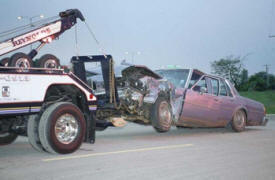 Decrease traffic deaths-
DPS works on several fronts to reduce the number of traffic fatalities.
The Minnesota State Patrol, Office of Traffic Safety, Driver and Vehicle
Services, the Office of Communication, and partners in government,
business, and non-profit organizations all play a role in achieving the
set goals. The strategies used include public education, media
relations, enforcement of laws, and support of traffic safety programs
conducted at the local level in cities and counties across the state.
The support of data bases assist the agencies in identifying the
specifics of the problem and evaluating the effectiveness of the
programs employed. The department also partners with community
coalitions, sheriffs’ offices and police departments, advisory boards,
school districts, safety advocates’ organizations and networks, and
other state and federal agencies with similar goals. Since 2001 these
collaborative efforts have become known as Towards Zero Deaths (TZD)
strategies. Decrease traffic deaths-
DPS works on several fronts to reduce the number of traffic fatalities.
The Minnesota State Patrol, Office of Traffic Safety, Driver and Vehicle
Services, the Office of Communication, and partners in government,
business, and non-profit organizations all play a role in achieving the
set goals. The strategies used include public education, media
relations, enforcement of laws, and support of traffic safety programs
conducted at the local level in cities and counties across the state.
The support of data bases assist the agencies in identifying the
specifics of the problem and evaluating the effectiveness of the
programs employed. The department also partners with community
coalitions, sheriffs’ offices and police departments, advisory boards,
school districts, safety advocates’ organizations and networks, and
other state and federal agencies with similar goals. Since 2001 these
collaborative efforts have become known as Towards Zero Deaths (TZD)
strategies.
-
Decrease fire deaths- The State Fire
Marshal (SFM) in DPS protects lives by fostering a fire safe environment
through public education, regulation, investigation, and data
collection. Through community fire safety education programs such as the
Risk Watch Team Program and Minnesota Juvenile Fire-Setter Intervention
Program, the SFM partners with schools, law enforcement, health
associations, and the justice system to
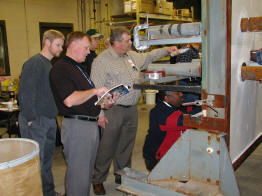 promote fire safety and safer
communities. The SFM conducts inspections of hotels, motels, resorts,
day care facilities, schools, hospitals, nursing homes, group homes, foster
care facilities, correctional facilities, and other places of assembly.
In addition, inspectors conduct site visits and provide consultation to
fire officials, architects, engineers, contractors, building inspectors,
government officials, building owners/operators, and the general public
regarding specific fire and life safety problems or concerns. SFM
assists local fire departments by performing arson investigations and
collecting and analyzing data from incident reports through the
Minnesota Fire Incident Reporting System (MFIRS). Comprehensive data
collected from the MFIRS enables the SFM to identify the need to develop
and implement new programs, or redirect existing programs as well as
generate and support data that may justify the acquisition of additional
resources. Information gathered via the MFIRS helps reduce the needless
loss of life. The SFM indicates that currently 96% of all Minnesota fire
departments are reporting into the MFIRS fire incident system,
allowing the SFM to have a better understanding of the fire issues in
Minnesota. promote fire safety and safer
communities. The SFM conducts inspections of hotels, motels, resorts,
day care facilities, schools, hospitals, nursing homes, group homes, foster
care facilities, correctional facilities, and other places of assembly.
In addition, inspectors conduct site visits and provide consultation to
fire officials, architects, engineers, contractors, building inspectors,
government officials, building owners/operators, and the general public
regarding specific fire and life safety problems or concerns. SFM
assists local fire departments by performing arson investigations and
collecting and analyzing data from incident reports through the
Minnesota Fire Incident Reporting System (MFIRS). Comprehensive data
collected from the MFIRS enables the SFM to identify the need to develop
and implement new programs, or redirect existing programs as well as
generate and support data that may justify the acquisition of additional
resources. Information gathered via the MFIRS helps reduce the needless
loss of life. The SFM indicates that currently 96% of all Minnesota fire
departments are reporting into the MFIRS fire incident system,
allowing the SFM to have a better understanding of the fire issues in
Minnesota.
-
Maintain zero death toll from utility line
excavation- The DPS Office of Pipeline Safety (MNOPS) protects lives
and the environment from gas and hazardous liquid accidents/incidents by educating citizens and
inspecting all pipeline facilities in
Minnesota. MNOPS conducts “dig safely” and other important educational
seminars throughout
the year to spread the message about the critical need to identify all
underground utility lines prior to digging. Whether you are a homeowner
planting a tree or an excavator constructing a road it is essential that
underground utilities are appropriately marked. Since 1998, MNOPS has
made 895 damage prevention presentations to 63,457 individuals. To date,
no lives have been lost due to unmarked utilities.
What is the department’s progress to date?
After years of slow but steady increases, seat belt usage in Minnesota
has reached a plateau. The percentage of Minnesotans using seat belts was
82% in the 2004 observational survey, 84% in 2005, and 83% in 2006. The OTS
and MSP believe with continued emphasis on enforcement of our occupant
protection laws and by increasing media attention and public information,
seat belt use can rise again.
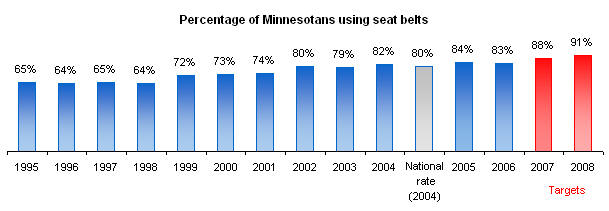
The State Fire Marshal’s (SFM) office collaborates with
local communities to provide training, enabling the local departments to
host effective community educational programs and provide media tools for
imparting vital safety messages at various community gatherings.
|
|
Learn more at:
 Department of Public Safety home page
Department of Public Safety home page
www.dps.state.mn.us |
| |
|
Goal:
Coordinate
homeland security and emergency preparedness for Minnesotans |
|
Why is this goal important?
The primary
function of the Department of Public Safety is to protect the citizens we
serve. The Homeland Security and Emergency Management (HSEM) Division of DPS
is the lead agency for planning, preparing and responding to situations
which endanger the security and safety of Minnesotans. The ability to
coordinate efforts and resources has proven to be the most strategic
approach to preventing, reducing, solving and responding to crime or
disasters
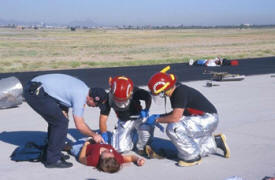 whether
they are man-made or natural. HSEM maintains an aggressive anti-terrorism
response and prevention plan built upon the cooperation of all levels of
government. DPS strives to uphold the trust of the public, ensuring them
that their safety and security is vital and that DPS will use all of it’s
resources, partnerships, and services to achieve this goal. DPS will
increase citizen awareness and preparedness for responding to an emergency
situation. HSEM encourages citizen awareness by supporting The Minnesota
Citizen Corps Council (MCCC), one of the first state-level Citizen Corps
Councils in the nation. HSEM sponsors several other community awareness and
preparedness campaigns and programs for Minnesota citizens. Severe Weather
and Winter Hazard Awareness Weeks are two campaigns that HSEM presents with
the cooperation of several other state agencies and the American Red Cross
to encourage citizens to be aware of the changes in our weather and to plan
ahead when necessary. HSEM produced and maintains an up to date planning
guide for Minnesota schools in conjunction with the Dept. of Education to
assist school districts in their comprehensive emergency plans which are
required by law. Being prepared will save lives. whether
they are man-made or natural. HSEM maintains an aggressive anti-terrorism
response and prevention plan built upon the cooperation of all levels of
government. DPS strives to uphold the trust of the public, ensuring them
that their safety and security is vital and that DPS will use all of it’s
resources, partnerships, and services to achieve this goal. DPS will
increase citizen awareness and preparedness for responding to an emergency
situation. HSEM encourages citizen awareness by supporting The Minnesota
Citizen Corps Council (MCCC), one of the first state-level Citizen Corps
Councils in the nation. HSEM sponsors several other community awareness and
preparedness campaigns and programs for Minnesota citizens. Severe Weather
and Winter Hazard Awareness Weeks are two campaigns that HSEM presents with
the cooperation of several other state agencies and the American Red Cross
to encourage citizens to be aware of the changes in our weather and to plan
ahead when necessary. HSEM produced and maintains an up to date planning
guide for Minnesota schools in conjunction with the Dept. of Education to
assist school districts in their comprehensive emergency plans which are
required by law. Being prepared will save lives.
How can this goal be accomplished?
-
Increase the capacity of state and local
governments in preparing for and responding to all types of disasters.
HSEM coordinates a statewide approach to plan, prepare and respond
to disasters and terrorism. HSEM will continue to provide multiple
training and exercise opportunities for state agencies and local
jurisdictions each year. Minnesota’s local emergency responders will be
encouraged to participate in Weapons of Mass Destruction (WMD) Awareness
Training. HSEM will also continue to identify the resources needed to
efficiently and effectively respond by conducting gap analyses and
prioritizing the funding received based on the identified gaps. HSEM
continues to partner with state professional associations, the Minnesota
State College and University System, and federal training partners for the
delivery of WMD training.
-
Increase collaboration efforts to improve
public safety communication and interoperability. Interoperability
is the ability of a radio user from one agency to speak to a radio user
of any other agency or municipality. Through The Department of Public
Safety’s Allied Radio Matrix for Emergency Response (ARMER) program
administrators will continue to alert state and local public safety
first responders, legislators and the public about the critical need for
communication interoperability in Minnesota. With funding being a major
hurdle, DPS will continue to work to secure funds at the local, state
and federal level for the build out of the system and will administer
money as it becomes available for the completion of these projects in
accordance with the project plan.
What is the department’s progress to date?
HSEM has implemented a statewide
homeland security strategy. Progress includes an update added in
December 2006 that incorporates regional collaboration goals and stresses
the sharing of regional resources. The Minnesota Citizens Corp Council will continue to conduct at
least 2 educational presentations to communities each year which includes an
HSEM-sponsored Citizens Corps Conference scheduled for September 2007. To help increase
the capacity of local
governments to respond to emergencies, HSEM will
host a minimum of 30 Emergency Management training classes in 2007 to community
leaders and local emergency managers.
In
2006, eight regional, multi-agency disaster response exercises were
conducted. Currently 45% of emergency responders
have been trained in WMD awareness.
All eighty seven counties have incorporated a chemical,
biological, radiological, nuclear and explosive (CBRNE) response plan into
their existing all hazard plan.
Collapsed Structure Rescue teams have been established and identified as
Minneapolis Fire for the Heavy Rescue Team and Saint Paul Fire, Edina Fire,
Rochester Fire, and Dakota County Special Operations as Medium Rescue Teams.
All of the equipment needed for response is on hand for these teams. Each
team continues to receive grant funding for training which is currently
underway, and for the most part, has been
completed for basic response. Additional grant funding will be focused at
upgrading equipment as needed and for advanced-level training for command
portions of the Collapsed Structure Rescue Teams. The
Minneapolis Team was deployed to the explosion in Ramsey Minnesota on
December 28, 2004 and utilized much of the equipment purchased under the
program during the search and rescue operations.
The
DPS ARMER Program will continue implementation of a statewide shared
interoperable radio system throughout the state.
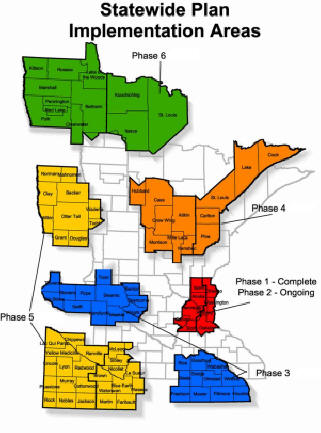
Project Status:
• The Metro Area Regional Backbone System (Phase 1)
was funded in 1997,
contracted for in 1999, and has been successfully operating since 2001.
• The Metro Area Local Subsystem Additions (Phase 2) have been progressing
since the initial backbone deployment in 1999 and all seven counties of the
metropolitan area will be operating on the ARMER system by the end of 2008.
• The Rochester and Saint Cloud Regional Backbone Systems (Phase 3) were
funded in the 2005 legislative session and are currently under construction.
Local Subsystem additions in Olmsted Co. / Rochester and Stearns Co. / St.
Cloud are already in place and operating. The estimated completion for the
Phase 3 backbone is mid 2008.
• The implementation of the ARMER system backbone in the remaining 55
counties the state was funded in 2007. Implementation will begin in 2008
following completion of the detail design work. Implementation in the
remaining 55 counties of the state will occur over the next four years with
completion anticipated by 2012.
|
|
Learn more
at:
 Department of Public Safety home page
Department of Public Safety home page
www.dps.state.mn.us |
| |
|
Goal:
Support the
criminal justice system through the use of technology |
|
Why is this goal important?
The Department of Public Safety plays an essential role in the support of
federal, state and local criminal justice practitioners. DPS provides vital
resources such as integrated criminal justice information, criminal history
information, criminal investigative assistance and forensic science
services. DPS provides and maintains accurate driver’s license and motor
vehicle information for the legal and law enforcement communities.
How can this goal be accomplished?
-
 Provide
vital assistance to the criminal justice community- The Bureau of
Criminal Apprehension (BCA) laboratory in DPS provides expert scientific
coordination, forensic examination, state-of-the-art investigative
techniques and sophisticated technology in the investigation of physical
evidence for the entire criminal justice community in Minnesota. The BCA
lab also collaborates with the FBI by submitting DNA offender profiles
to the national database and with the Bureau of Alcohol, Tobacco and
Firearms (ATF) by submitting weapon cartridge case samples to the
Integrated Ballistic Information Network. This is expertise that the
vast majority of law enforcement agencies cannot locally support. The
BCA investigative units partner with federal, state and local law
enforcement to provide expertise in the felony investigation of violent
crimes, drug trafficking and kidnappings. The BCA also maintains the
Predatory Offender Registration system with 19,000 offenders. Provide
vital assistance to the criminal justice community- The Bureau of
Criminal Apprehension (BCA) laboratory in DPS provides expert scientific
coordination, forensic examination, state-of-the-art investigative
techniques and sophisticated technology in the investigation of physical
evidence for the entire criminal justice community in Minnesota. The BCA
lab also collaborates with the FBI by submitting DNA offender profiles
to the national database and with the Bureau of Alcohol, Tobacco and
Firearms (ATF) by submitting weapon cartridge case samples to the
Integrated Ballistic Information Network. This is expertise that the
vast majority of law enforcement agencies cannot locally support. The
BCA investigative units partner with federal, state and local law
enforcement to provide expertise in the felony investigation of violent
crimes, drug trafficking and kidnappings. The BCA also maintains the
Predatory Offender Registration system with 19,000 offenders.
-
Provide essential electronic data to criminal
justice partners- The Driver and Vehicle Services (DVS) Division
continues to improve its secured access to DVS data for business
partners and law enforcement. This is achieved through availability of
Web-based services.
The quality of data
will continue to be improved by reducing error rates, by developing and
implementing anti-fraud policies and procedures, and by improving audit
capabilities and communication tools. The BCA
Criminal Justice Information Services division (CJIS) manages a statewide dedicated
network and a series of justice information systems that provide the
criminal justice community instant access to critical information
relating to crimes and criminals. These systems include statewide
criminal histories, information on wanted/missing persons, stolen guns,
orders for protection, predatory offenders, gang members, vehicles, and
property.
CJIS also provides links to over 75,000 criminal justice agencies in the
United States, Canada, and Mexico. The CJIS Criminal Justice Data
Network (CJDN) offers instantaneous access to data for law enforcement
officers, dispatchers, courts, corrections officials, public defenders,
county attorneys, DNR, and the Dept of Human Services as well as federal
agencies in the network. The number of users on the CJDN is
approximately 12,000. CriMNet is a BCA program to facilitate the
integration of Minnesota’s criminal justice information systems. The
overall scope of CriMNet is to develop a common set of business and
technical standards for statewide information sharing and to foster the
collaborative efforts of criminal justice agencies throughout the state.
The CriMNet Program
completed agency business and technical assessments in early 2006. A
comprehensive framework or blueprint that outlines the priorities for
statewide integration of criminal justice information was completed in
December 2006 and was subsequently adopted by criminal justice
stakeholders.
What is the department’s progress to date?
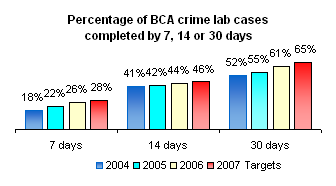 The BCA will be working to increase the number of
crime lab cases
completed in less than 30 days from the actual 61% in 2006 to 65% in 2007. The BCA will be working to increase the number of
crime lab cases
completed in less than 30 days from the actual 61% in 2006 to 65% in 2007.
Fingerprint intake has grown by over 200% since 1997
due to the BCA’s efforts to promote the importance of submitting
fingerprints and the deployment of electronic fingerprint capture devices
referred to as Livescan. The BCA began receiving Livescan submissions in
September 2000, during that first month 2,400 Livescan submissions were
received. For calendar year 2005, Livescan submissions averaged over 11,900
per month, paper cards averaged 1,040 per month. In terms of all
submissions, calendar year 2005 showed that 92% of all fingerprint cards
received were submitted via Livescan devices.
In calendar year 2006, Livescan
submissions averaged over 13,200 per month and paper 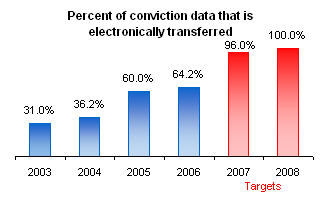 cards (the old “ink and
roll”) averaged 275 per month. In terms of all submissions, calendar year
2006 showed that 98% of all fingerprint cards received were submitted via Livescan devices. cards (the old “ink and
roll”) averaged 275 per month. In terms of all submissions, calendar year
2006 showed that 98% of all fingerprint cards received were submitted via Livescan devices.
In 2006, 64.2 % of conviction data that
DVS received from the courts was transferred electronically. The goal is to
increase that amount to 96% in FY 2007, and to 100% in FY 2008.
|
|
Learn more at:
 Department of Public Safety home page
Department of Public Safety home page
www.dps.state.mn.us
|
| |
|
Goal:
Increase
compliance with Minnesota laws relating to driving, fires, pipeline
regulations, and alcohol and gambling |
|
Why is this goal important?
Enforcing the law is essential to providing a safe environment for
Minnesotans. Whether citizens are at work, traveling, in their homes or
enjoying leisure or sporting activities, it is their right to feel safe and
secure. It is the responsibility of the Department of Public Safety to
regulate and uphold laws that have been entrusted to us to enforce.
How can this goal be accomplished?
-
 Enforce Minnesota roadway laws- The
Minnesota State Patrol’s (MSP) primary role will continue to be
enforcement of laws regulating the use of the state’s highways with
special emphasis on removing impaired drivers. MSP’s commercial vehicle
enforcement mobile and fixed units enforce state and federal laws
regulating the size, weight, load and operation of commercial vehicles
traveling on the state and federal trunk highway system, ensuring safe
motoring for all vehicles on Minnesota roadways. Specialized school bus
inspectors perform annual and random inspections of school buses to
enforce compliance of safety equipment regulations, vehicle mechanical
conditions and driver documentation. MSP enforcement efforts resulted in
325,971 driver/vehicle contacts and 7,036 DWI arrests in 2005. Enforce Minnesota roadway laws- The
Minnesota State Patrol’s (MSP) primary role will continue to be
enforcement of laws regulating the use of the state’s highways with
special emphasis on removing impaired drivers. MSP’s commercial vehicle
enforcement mobile and fixed units enforce state and federal laws
regulating the size, weight, load and operation of commercial vehicles
traveling on the state and federal trunk highway system, ensuring safe
motoring for all vehicles on Minnesota roadways. Specialized school bus
inspectors perform annual and random inspections of school buses to
enforce compliance of safety equipment regulations, vehicle mechanical
conditions and driver documentation. MSP enforcement efforts resulted in
325,971 driver/vehicle contacts and 7,036 DWI arrests in 2005.
-
Enforce Minnesota utility identification
regulations and fire codes- Minnesota Office of Pipeline Safety (MNOPS)
promotes incident prevention by enforcing the Gopher State One-Call law
(Minn. Statute §216 D) requiring excavators to call before they dig and
utility operators to mark their facilities to prevent utility line
exposure, hazardous gas or liquid leaks that could lead to a
catastrophic incident. MNOPS works cooperatively with the National
Transportation Safety Board, the U.S. DOT/OPS and the Minnesota
Pollution Control Agency on enforcement objectives and the investigation
of incidents. MNOPS inspectors issued over 6,049 citations for
violations of state and federal safety codes between
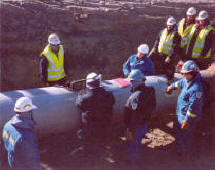 1994
and 2006. Through
building fire safety inspections the State Fire Marshal (SFM) enforces compliance of
Minnesota Fire Codes regarding safety necessities such as fire escapes,
emergency exits, flammable materials, lighting, sprinklers, and alarms
in residential dwellings as well as businesses or commercial buildings.
The SFM regulates the fire sprinkler protection industry through
licensing and/or certification of contractors and sprinkler fitters,
ensuring that contractors and designers of automatic fire protection
systems are complying with state regulations and correctly designing
sprinkler
systems. 1994
and 2006. Through
building fire safety inspections the State Fire Marshal (SFM) enforces compliance of
Minnesota Fire Codes regarding safety necessities such as fire escapes,
emergency exits, flammable materials, lighting, sprinklers, and alarms
in residential dwellings as well as businesses or commercial buildings.
The SFM regulates the fire sprinkler protection industry through
licensing and/or certification of contractors and sprinkler fitters,
ensuring that contractors and designers of automatic fire protection
systems are complying with state regulations and correctly designing
sprinkler
systems.
-
Enforce Minnesota Alcohol and Gambling
statutes- The DPS Alcohol and Gambling Enforcement Division (AGE)
maintains the integrity of legalized gambling, detects and vigorously
pursues illegal forms of gambling, enforces the state's liquor laws, and
monitors the State/Tribal gaming compacts. By conducting underage
compliance checks and applying several enforcement techniques, the
Alcohol Enforcement Division can prevent liquor establishments from
selling to minors and can arrest adult violators for providing alcohol
to juveniles. Alcohol investigators conduct criminal investigations of
alcohol-related complaints regarding unlicensed sale, importation,
manufacture of alcoholic beverages, unregistered product introduction
into the state, and contamination. AGE collaborates with local law
enforcement and prosecutors to take legal action against those involved
in unlawful gaming or illegal alcohol practices.
What is the department’s progress to date?
Over the past few years, the number of traffic fatalities and the percentage
of them that are alcohol-related have fluctuated. There were 568 traffic
deaths in Minnesota in 2001, 37% were alcohol related. In 2002, 657 and in
2003, 655; (36 and 39% respectively were alcohol related). Calendar year 2004
fatalities were 567, with 31% being alcohol related.
Eighty-five percent of crash reports are currently
complied and audited for 2005, they indicate that of the 559 deaths, 35.24%
were alcohol related.
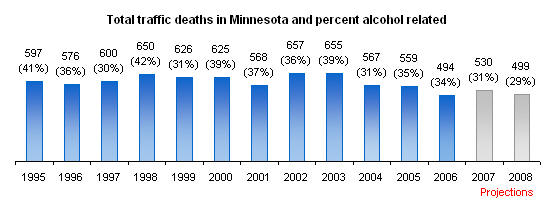
Through the “Enforcing Underage Drinking Laws” (EUDL)
grant, AGE is able to fund local police and sheriffs for conducting
compliance checks alternative enforcement techniques to reduce Minnesota
youth’s access to alcohol. In 2005, 2,376 underage compliance checks were
conducted in 60 municipalities with a 90% compliance rate. In 2005, 859
arrests were also made utilizing alternative underage alcohol enforcement
techniques. AGED underage alcohol liaison conducted training and
informational seminars for 2,000 individuals at 70 locations in 2005.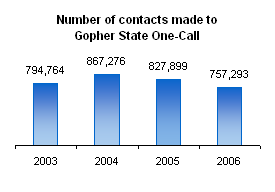
The Minnesota Office of Pipeline Safety reports that
757,293 contacts were made to Gopher State One Call for utility
identification requests in 2006. It is anticipated that the number of
homeowner tickets will continue to rise with the creation of the three digit
dialing number, 811. 811, a federally-mandated national "Call Before You
Dig" number, was established on May 1, 2007 to help protect citizens from
unintentionally hitting underground utility lines while working on digging
projects.
|
|
Learn more
at:
 Department of Public Safety home page
Department of Public Safety home page
www.dps.state.mn.us
 CrimNet home page
CrimNet home page
http://www.crimnet.state.mn.us/
 Driver and Vehicle Services home page
Driver and Vehicle Services home page
http://www.mndriveinfo.org |
|
|
|
Some images © 2003 www.clipart.com |
|
Last update on
07/30/2007
|
|


 Decrease traffic deaths-
DPS works on several fronts to reduce the number of traffic fatalities.
The Minnesota State Patrol, Office of Traffic Safety, Driver and Vehicle
Services, the Office of Communication, and partners in government,
business, and non-profit organizations all play a role in achieving the
set goals. The strategies used include public education, media
relations, enforcement of laws, and support of traffic safety programs
conducted at the local level in cities and counties across the state.
The support of data bases assist the agencies in identifying the
specifics of the problem and evaluating the effectiveness of the
programs employed. The department also partners with community
coalitions, sheriffs’ offices and police departments, advisory boards,
school districts, safety advocates’ organizations and networks, and
other state and federal agencies with similar goals. Since 2001 these
collaborative efforts have become known as Towards Zero Deaths (TZD)
strategies.
Decrease traffic deaths-
DPS works on several fronts to reduce the number of traffic fatalities.
The Minnesota State Patrol, Office of Traffic Safety, Driver and Vehicle
Services, the Office of Communication, and partners in government,
business, and non-profit organizations all play a role in achieving the
set goals. The strategies used include public education, media
relations, enforcement of laws, and support of traffic safety programs
conducted at the local level in cities and counties across the state.
The support of data bases assist the agencies in identifying the
specifics of the problem and evaluating the effectiveness of the
programs employed. The department also partners with community
coalitions, sheriffs’ offices and police departments, advisory boards,
school districts, safety advocates’ organizations and networks, and
other state and federal agencies with similar goals. Since 2001 these
collaborative efforts have become known as Towards Zero Deaths (TZD)
strategies. 
 whether
they are man-made or natural. HSEM maintains an aggressive anti-terrorism
response and prevention plan built upon the cooperation of all levels of
government. DPS strives to uphold the trust of the public, ensuring them
that their safety and security is vital and that DPS will use all of it’s
resources, partnerships, and services to achieve this goal. DPS will
increase citizen awareness and preparedness for responding to an emergency
situation. HSEM encourages citizen awareness by supporting The Minnesota
Citizen Corps Council (MCCC), one of the first state-level Citizen Corps
Councils in the nation. HSEM sponsors several other community awareness and
preparedness campaigns and programs for Minnesota citizens. Severe Weather
and Winter Hazard Awareness Weeks are two campaigns that HSEM presents with
the cooperation of several other state agencies and the American Red Cross
to encourage citizens to be aware of the changes in our weather and to plan
ahead when necessary. HSEM produced and maintains an up to date planning
guide for Minnesota schools in conjunction with the Dept. of Education to
assist school districts in their comprehensive emergency plans which are
required by law. Being prepared will save lives.
whether
they are man-made or natural. HSEM maintains an aggressive anti-terrorism
response and prevention plan built upon the cooperation of all levels of
government. DPS strives to uphold the trust of the public, ensuring them
that their safety and security is vital and that DPS will use all of it’s
resources, partnerships, and services to achieve this goal. DPS will
increase citizen awareness and preparedness for responding to an emergency
situation. HSEM encourages citizen awareness by supporting The Minnesota
Citizen Corps Council (MCCC), one of the first state-level Citizen Corps
Councils in the nation. HSEM sponsors several other community awareness and
preparedness campaigns and programs for Minnesota citizens. Severe Weather
and Winter Hazard Awareness Weeks are two campaigns that HSEM presents with
the cooperation of several other state agencies and the American Red Cross
to encourage citizens to be aware of the changes in our weather and to plan
ahead when necessary. HSEM produced and maintains an up to date planning
guide for Minnesota schools in conjunction with the Dept. of Education to
assist school districts in their comprehensive emergency plans which are
required by law. Being prepared will save lives. 
 Provide
vital assistance to the criminal justice community- The Bureau of
Criminal Apprehension (BCA) laboratory in DPS provides expert scientific
coordination, forensic examination, state-of-the-art investigative
techniques and sophisticated technology in the investigation of physical
evidence for the entire criminal justice community in Minnesota. The BCA
lab also collaborates with the FBI by submitting DNA offender profiles
to the national database and with the Bureau of Alcohol, Tobacco and
Firearms (ATF) by submitting weapon cartridge case samples to the
Integrated Ballistic Information Network. This is expertise that the
vast majority of law enforcement agencies cannot locally support. The
BCA investigative units partner with federal, state and local law
enforcement to provide expertise in the felony investigation of violent
crimes, drug trafficking and kidnappings. The BCA also maintains the
Predatory Offender Registration system with 19,000 offenders.
Provide
vital assistance to the criminal justice community- The Bureau of
Criminal Apprehension (BCA) laboratory in DPS provides expert scientific
coordination, forensic examination, state-of-the-art investigative
techniques and sophisticated technology in the investigation of physical
evidence for the entire criminal justice community in Minnesota. The BCA
lab also collaborates with the FBI by submitting DNA offender profiles
to the national database and with the Bureau of Alcohol, Tobacco and
Firearms (ATF) by submitting weapon cartridge case samples to the
Integrated Ballistic Information Network. This is expertise that the
vast majority of law enforcement agencies cannot locally support. The
BCA investigative units partner with federal, state and local law
enforcement to provide expertise in the felony investigation of violent
crimes, drug trafficking and kidnappings. The BCA also maintains the
Predatory Offender Registration system with 19,000 offenders.  The BCA will be working to increase the number of
crime lab cases
completed in less than 30 days from the actual 61% in 2006 to 65% in 2007.
The BCA will be working to increase the number of
crime lab cases
completed in less than 30 days from the actual 61% in 2006 to 65% in 2007.
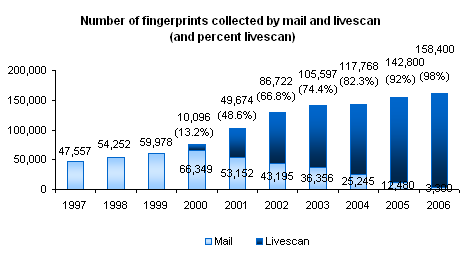
 cards (the old “ink and
roll”) averaged 275 per month. In terms of all submissions, calendar year
2006 showed that 98% of all fingerprint cards received were submitted via Livescan devices.
cards (the old “ink and
roll”) averaged 275 per month. In terms of all submissions, calendar year
2006 showed that 98% of all fingerprint cards received were submitted via Livescan devices.  Enforce Minnesota roadway laws- The
Minnesota State Patrol’s (MSP) primary role will continue to be
enforcement of laws regulating the use of the state’s highways with
special emphasis on removing impaired drivers. MSP’s commercial vehicle
enforcement mobile and fixed units enforce state and federal laws
regulating the size, weight, load and operation of commercial vehicles
traveling on the state and federal trunk highway system, ensuring safe
motoring for all vehicles on Minnesota roadways. Specialized school bus
inspectors perform annual and random inspections of school buses to
enforce compliance of safety equipment regulations, vehicle mechanical
conditions and driver documentation. MSP enforcement efforts resulted in
325,971 driver/vehicle contacts and 7,036 DWI arrests in 2005.
Enforce Minnesota roadway laws- The
Minnesota State Patrol’s (MSP) primary role will continue to be
enforcement of laws regulating the use of the state’s highways with
special emphasis on removing impaired drivers. MSP’s commercial vehicle
enforcement mobile and fixed units enforce state and federal laws
regulating the size, weight, load and operation of commercial vehicles
traveling on the state and federal trunk highway system, ensuring safe
motoring for all vehicles on Minnesota roadways. Specialized school bus
inspectors perform annual and random inspections of school buses to
enforce compliance of safety equipment regulations, vehicle mechanical
conditions and driver documentation. MSP enforcement efforts resulted in
325,971 driver/vehicle contacts and 7,036 DWI arrests in 2005.  1994
and 2006. Through
building fire safety inspections the State Fire Marshal (SFM) enforces compliance of
Minnesota Fire Codes regarding safety necessities such as fire escapes,
emergency exits, flammable materials, lighting, sprinklers, and alarms
in residential dwellings as well as businesses or commercial buildings.
The SFM regulates the fire sprinkler protection industry through
licensing and/or certification of contractors and sprinkler fitters,
ensuring that contractors and designers of automatic fire protection
systems are complying with state regulations and correctly designing
sprinkler
systems.
1994
and 2006. Through
building fire safety inspections the State Fire Marshal (SFM) enforces compliance of
Minnesota Fire Codes regarding safety necessities such as fire escapes,
emergency exits, flammable materials, lighting, sprinklers, and alarms
in residential dwellings as well as businesses or commercial buildings.
The SFM regulates the fire sprinkler protection industry through
licensing and/or certification of contractors and sprinkler fitters,
ensuring that contractors and designers of automatic fire protection
systems are complying with state regulations and correctly designing
sprinkler
systems.
